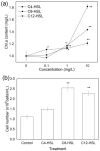Revealing the Bacterial Quorum-Sensing Effect on the Biofilm Formation of Diatom Cylindrotheca sp. Using Multimodal Imaging
- PMID: 37513013
- PMCID: PMC10383543
- DOI: 10.3390/microorganisms11071841
Revealing the Bacterial Quorum-Sensing Effect on the Biofilm Formation of Diatom Cylindrotheca sp. Using Multimodal Imaging
Abstract
Diatoms contribute to carbon fixation in the oceans by photosynthesis and always form biofouling organized by extracellular polymeric substances (EPS) in the marine environment. Bacteria-produced quorum-sensing signal molecules N-acyl homoserine lactones (AHLs) were found to play an important role in the development of Cylindrotheca sp. in previous studies, but the EPS composition change was unclear. This study used the technology of alcian blue staining and scanning electron microscopy (SEM), confocal laser scanning microscopy (CLSM), and time-of-flight secondary ion mass spectrometry (ToF-SIMS) to directly observe the biofilm formation process. The results showed that AHLs promote the growth rates of diatoms and the EPS secretion of biofilm components. AHLs facilitated the diatom-biofilm formation by a forming process dependent on the length of carbon chains. AHLs increased the biofilm thickness and the fluorescence intensity and then altered the three-dimensional (3D) structures of the diatom-biofilm. In addition, the enhanced EPS content in the diatom-biofilm testified that AHLs aided biofilm formation. This study provides a collection of new experimental evidence of the interaction between bacteria and microalgae in fouling biofilms.
Keywords: N-acyl homoserine lactone; ToF-SIMS; biofilm; diatom; extracellular polymeric substances; morphology.
Conflict of interest statement
The authors declare no conflict of interest.
Figures





Similar articles
-
The possible role of bacterial signal molecules N-acyl homoserine lactones in the formation of diatom-biofilm (Cylindrotheca sp.).Mar Pollut Bull. 2016 Jun 15;107(1):118-124. doi: 10.1016/j.marpolbul.2016.04.010. Epub 2016 Apr 16. Mar Pollut Bull. 2016. PMID: 27090887
-
Facilitating nitrification and biofilm formation of Vibrio sp. by N-acyl-homoserine lactones in high salinity environment.Bioprocess Biosyst Eng. 2024 Mar;47(3):325-339. doi: 10.1007/s00449-023-02962-6. Epub 2024 Feb 12. Bioprocess Biosyst Eng. 2024. PMID: 38345624
-
Estimation of spatial distribution of quorum sensing signaling in sequencing batch biofilm reactor (SBBR) biofilms.Sci Total Environ. 2018 Jan 15;612:405-414. doi: 10.1016/j.scitotenv.2017.07.277. Epub 2017 Sep 1. Sci Total Environ. 2018. PMID: 28858750
-
Do biological-based strategies hold promise to biofouling control in MBRs?Water Res. 2013 Oct 1;47(15):5447-63. doi: 10.1016/j.watres.2013.06.033. Epub 2013 Jun 27. Water Res. 2013. PMID: 23863390 Review.
-
[Wastewater treatment based on biofilm regulation by Lux type quorum sensing system-a review].Sheng Wu Gong Cheng Xue Bao. 2017 Sep 25;33(9):1596-1610. doi: 10.13345/j.cjb.170146. Sheng Wu Gong Cheng Xue Bao. 2017. PMID: 28956404 Review. Chinese.
Cited by
-
Unraveling the Diverse Profile of N-Acyl Homoserine Lactone Signals and Their Role in the Regulation of Biofilm Formation in Porphyra haitanensis-Associated Pseudoalteromonas galatheae.Microorganisms. 2023 Sep 4;11(9):2228. doi: 10.3390/microorganisms11092228. Microorganisms. 2023. PMID: 37764072 Free PMC article.
-
ToF-SIMS evaluation of PEG-related mass peaks and applications in PEG detection in cosmetic products.Sci Rep. 2024 Jul 1;14(1):14980. doi: 10.1038/s41598-024-65504-4. Sci Rep. 2024. PMID: 38951137 Free PMC article.
-
Diatom-Bacteria Interactions in the Marine Environment: Complexity, Heterogeneity, and Potential for Biotechnological Applications.Microorganisms. 2023 Dec 12;11(12):2967. doi: 10.3390/microorganisms11122967. Microorganisms. 2023. PMID: 38138111 Free PMC article. Review.
References
-
- El-saied H.A.-A., Ibrahim A.M. Effective fabrication and characterization of eco-friendly nano chitosan capped zinc oxide nanoparticles for effective marine fouling inhibition. J. Environ. Chem. Eng. 2020;8:103949. doi: 10.1016/j.jece.2020.103949. - DOI
-
- Rajitha K., Nancharaiah Y.V., Venugopalan V.P. Insight into bacterial biofilm-barnacle larvae interactions for environmentally benign antifouling strategies. Int. Biodeterior. Biodegrad. 2020;149:104937. doi: 10.1016/j.ibiod.2020.104937. - DOI
-
- Rajitha K., Nancharaiah Y.V., Venugopalan V.P. Role of bacterial biofilms and their eps on settlement of barnacle (amphibalanus reticulatus) larvae. Int. Biodeterior. Biodegrad. 2020;150:104958. doi: 10.1016/j.ibiod.2020.104958. - DOI
-
- Najid N., Hakizimana J.N., Kouzbour S., Gourich B., Ruiz-García A., Vial C., Stiriba Y., Semiat R. Fouling control and modeling in reverse osmosis for seawater desalination: A review. Comput. Chem. Eng. 2022;162:107794. doi: 10.1016/j.compchemeng.2022.107794. - DOI
Grants and funding
LinkOut - more resources
Full Text Sources

